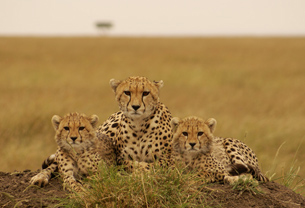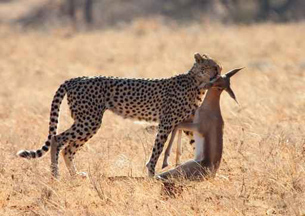Module 8
1. Module 8
1.1. Big Picture
Module 8—Populations, Individuals, and Gene Pools
 Big Picture
Big Picture

© Traveler/12606712/Fotolia
The beautiful, sleek predators shown in the pictures are cheetahs of the African Serengeti. Wouldn’t it be amazing to observe a family of wild cheetahs in Tanzania or Kenya? If you stay quiet and still, you may be able to watch the perfectly camouflaged mother and cubs in the tall, dry, yellow grass. They have their eyes on a herd of nearby antelope. You watch as the mother springs from the bush and uses her lightning speed and strong jaws to bring down the slowest of the fleeing herd of antelope as they disappear in a cloud of dust.

© Luc PATUREAU/1252507/Fotolia
Later, at your lodge, the naturalist tells you that cheetahs are considered “biologically extinct” because of a lack of variation in their gene pool. Apparently modern cheetahs are so genetically alike that skin grafts between individuals are not rejected—much like identical twins. The naturalist explains that because cheetahs are so similar, any micro-organism or environmental change that affects some will affect all, and it may be only a matter of time before the species becomes extinct. Their lack of diversity means that no individuals would survive the change.
You are concerned to hear that human activities, such as agriculture, mining, and urban development, have decreased the cheetahs' natural habitat and prevented different cheetah populations from interbreeding. The naturalist worries that without the cheetah, the populations of wildebeest, zebra, and antelope (all cheetahs' natural prey) will not be kept in check, leading to the starvation and disease that accompany high density.
How can biologists possibly know how much genetic variation exists in a population or whether the population is changing? How is it possible to even count cheetahs in the wild, considering how well camouflaged they are and how fast they move? How do biologists predict how cheetah numbers affect other species that share their habitats?
You start to realize that park wildlife managers need to understand a great deal about the genetic, physical, and reproductive characteristics of cheetahs and the relationships cheetahs have with other organisms with whom they share the Serengeti. You get a glimpse of the problems that result when human activities that make life better for people limit the survival of the other species sharing the planet.
This module will explore the following focusing questions:
- How do biologists quantitatively describe the genetic composition of a population’s gene pool?
- What are the five conditions of the Hardy-Weinberg principle that affect frequency of alleles in a population, resulting in microevolution?
- What happens when conditions of the Hardy-Weinberg principle are not met?
- What factors cause changes in the diversity of gene pool composition?
- How can the Hardy-Weinberg Equation, involving allele and genotype frequencies in populations, graphs, and population data, be used to study changes in population over time?
- What are the intended and unintended consequences of human activities and scientific and technological developments on gene pools?
- What are the relationships that exist between species, and how can they contribute to population changes?
- What are the defence mechanisms that protect prey, enable predators, and allow organisms to compete successfully?
- How do communities and their populations change or remain stable over time?
- What are the factors that influence population size?
- How do these factors influence population change?
- How can data be analyzed to study population dynamics?
- What terms can be used to describe population dynamics and to give the data meaning?
- What are the different types of population growth patterns?
- How do growth patterns illustrate these types of changes over time?
- What are the characteristics and reproductive strategies of r- and K-selected organisms?
To help you organize the concepts you learn in Module 8, and to provide you with a study aid for review before you complete the Module Assessment, you may choose to download the Concept Organizer for Module 8. Fill in this concept organizer with the ideas you master as you work through each lesson, or prepare the organizer when you have completed Module 8. You can use keywords, point form, or any amount of detail that meets your needs. You may choose to work from the file on your computer, print the document and work from the paper copy, or copy the outline onto a large sheet of poster paper. After you have prepared your concept organizer, you may wish to check your work with the concept organizer provided in the Module Summary. The concept organizer provided outlines some of the key topics that you should include in each lesson of your concept organizer. This is a great tool to review and use for study purposes, but using this organizer is completely your choice.
Your Module Assessment will involve the application of your knowledge about the genetic composition of a population, and how it changes, and the way populations grow and relate to other species (including humans) that make up the communities in which they live. When you have completed all the lessons, you will need to complete one of the Module Assessment task options. For more details about the Module Assessment and the evaluation criteria, visit the Module Assessment section.